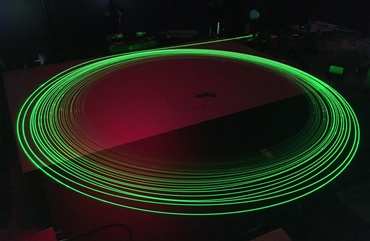Derrek Drachenberg (17-ERD-034)
Executive Summary
We are exploring the use of novel optical-fiber design technologies to scale the power of lasers in the 1.53–1.62-µm range, providing high atmospheric transmission and retina protection. High-power fiber lasers rated at tens of kilowatts at 1.55 µm will benefit Department of Defense applications such as directed-energy systems, lidar sensing, and free-space communication as well as Lawrence Livermore's lasers and optical science and technology core competency.
Project Description
High-average-power, diffraction-limited lasers are required for applications such as directed-energy systems, lidar sensing (lidar, or light detection and ranging, is the laser version of radar), and free-space communications. Fiber lasers are already well-suited for these tasks, except that today’s highest-power fiber lasers operate at wavelengths transparent to the human eye (800–1,100 nm) and thus could damage the retinas of battlefield participants or bystanders. Erbium-doped fiber lasers are challenged by the low solubility of erbium in fused-silica-based glasses, leading to long fiber lasers and nonlinear effects that limit these lasers to low power levels. The erbium ion can be effectively co-doped with an ytterbium ion to increase pump absorption. Erbium–ytterbium co-doped fiber lasers are more attractive, operating within a range of wavelengths where the fiber and the atmosphere transmit well (1,530–1,620 nm) and achieving efficiency up to 50 percent at low power. However, at higher power levels, the transfer of energy from the ytterbium ions to the erbium ions can encounter a bottleneck, leading to large ytterbium-ion inversions, high parasitic gain, and amplified spontaneous emission, or lasing around 1 µm. To date, only 300 W at 1,567 nm has been produced by an erbium–ytterbium co-doped laser, which was limited by the onset of 1-µm lasing at a very significant power level. We plan to develop the technologies needed to scale the power of lasers in the 1,530 to 1,620-nm range, providing high transmission in the atmosphere and retina protection. We also intend to investigate both high average power (kilowatts) and high peak power-and-pulse energy (5 mW). Our research, based on a highly wavelength-selective waveguide structure, enables development of kilowatt-level fiber lasers that are safer for eyes around 1.55 µm. This coincides with the lowest loss region in silica as well as an atmospheric transmission window, and could enable safer fiber-laser operation at tens of kilowatts for directed-energy applications.
Our goal is to leverage novel optical-fiber designs to power erbium–ytterbium co-doped fiber lasers at 1.55 µm and to mature the composition of erbium–ytterbium co-doped silica. We intend to (1) demonstrate the first kilowatt-level fiber laser at 1.55 µm; (2) demonstrate fiber designs capable of sustaining power loads of tens of kilowatts; (3) demonstrate the first diffraction-limited fiber laser at 1.55 µm with 2 to 5 mJ of pulse energy at 10 kHz; and (4) achieve improved erbium–ytterbium co-doped silica with 50 percent optical-to-optical efficiency and greater than 8-mm-diameter doped preformed material. If time allows, we will determine the feasibility of in-house rare-earth-doped glass development by sol-gel dip coating of glass rods followed by homogenization. (The sol-gel process is a wet chemical technique for material fabrication where the solution evolves gradually to a gel-like network.)
Mission Relevance
Our project to develop high-power fiber lasers that operate in an atmospheric transmission window and are at wavelengths safe for human eyes supports NNSA's goal of strengthening the nation's science, technology, and engineering base and Lawrence Livermore's lasers and optical science and technology core competency as well as the Laboratory's directed energy research-and-development challenge.
FY17 Accomplishments and Results
In FY17 we (1) built several amplifiers that should suppress the parasitic 1-µm light at low power (<10 W), but the efficiency was affected by the auxiliary device aluminum, which depresses the maximum phonon energy of the phosphorus-doped silicon-dioxide host; (2) obtained three acceptable erbium–ytterbium-phosphorus-doped preforms without aluminum; (3) began investigating causes of low efficiency; (4) commissioned 1.8 kW of pump diodes; (5) tested a polymer pump cladding; and (6) started modeling fiber designs.
   






